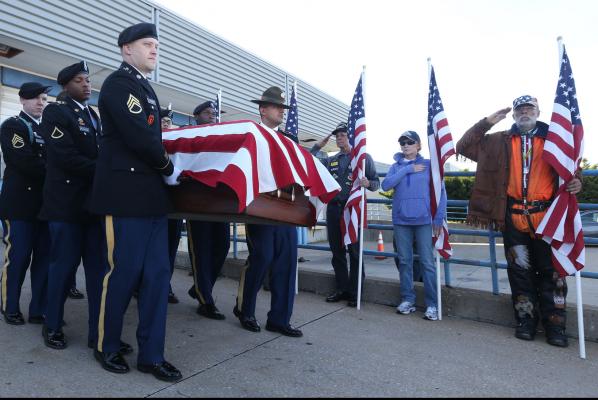
Nov. 10 (UPI) — It was the cornerstone of the Warrior Ethos in the U.S. Army — “I will never leave a fallen comrade” — that led U.S. Army serial number 16055052 home after 73 years.
It’s the “humbling mission” of the Defense Prisoner of War, Missing in Action Accounting Agency, based at Hickam Air Force Base in Hawaii. On Oct. 25, the DPAA brought home the remains of 16055052, whom the agency had identified as U.S. Army Staff Sgt. Michael Aiello, missing since World War II.
“You know, I tell people all the time that this is the most rewarding job I have ever had,” Lee Tucker, a DPAA public affairs officer, told UPI on Friday, a day ahead of Veterans Day. “It’s a humbling job to be able to tell the stories of men who gave their life for our country, who paid the ultimate sacrifice.
“There is just story after story of what these guys did, and if you talk to the family members…who don’t know what happened to their father or grandfather, their husband, cousin or brother…I don’t want to say provide closure because that’s a very personal thing, but to give somebody their name back, to provide a widow with the answer of what happened to their husband 50 years ago is just amazingly powerful.”
Aiello’s mission
Aiello served in the D-Day invasion of Normandy, France and the failed joint mission of British and American troops to end the war by Christmas 1944: Operation Market Garden.
Aiello grew up in Sherman, Ill., and became a coal miner at age 13 after finishing the eighth grade, according to records. By the time Japan attacked Pearl Harbor in December 1941, Aiello owned a restaurant in downtown Springfield. He entered the U.S. Army in 1942.
Defense Department records show Aiello was 35 when he went missing on Sept. 30, 1944, as a member of Company G, 401st Glider Infantry Regiment.
That was just five days after Market Garden failed to capture strategic positions around the city of Arnhem, Netherlands, where a key bridge crossing could have led allies over Rhine river and into Germany. Aiello’s unit had been assigned to the campaign that called for glider and airborne troops to seize the bridges in the Netherlands to allow British tank units to cross into Germany.
Aiello went missing during an intense four-day battle in the Kiekberg Woods near the Waal River bridge at Nijmegen. The War Department issued a presumptive finding that Aiello was killed in action.
More than 70 years later, his remains were exhumed from the Ardennes American Cemetery and sent to the DPAA laboratory for identification in May 2016. The DPAA laboratory conducted analysis, comparing the remains to DNA samples taken from Aiello’s relatives and found a match.
Expert team for delicate work
The DPAA’s mission is to recover personnel listed as prisoners of war or missing in action from all past wars and conflicts all over the world. The agency has an annual budget of $112 million.
Tucker said the agency, made up of civilian and military experts from all branches, successfully identifies about 200 service members each year.
“We have intelligence analysts that help us research our cases, to explosive ordnance disposal technicians that deploy out to the field with our research team to make sure these ancient battlefields are safe for our personnel,” he said.
Tucker recalls a mission to Tarawa in the in the Gilbert Islands, where the U.S. Marines fought the Japanese Army during World War II.
“We were doing an excavation and one of the villagers next to where we were digging comes to us and says, ‘Hey, I found a bomb, years ago, and it’s been sitting in my house ever since’. And it was this huge unexploded ordnance just sitting in his living room… We’re putting shovels into the ground, we need to make sure it’s safe for the team,” Tucker said.
Anthropologists, counterintelligence experts, human intelligence collectors, researchers and forensic specialists and linguists assemble into a 10-14 member research and investigation team.
They research archives in the host nation, investigate leads in “last known alive” cases and obtain oral histories about particular battles.
Over 82,000 unaccounted for
As of October, the agency is working to recover 82,429 soldiers, with many others pending administrative review. Most of them, 72,978, are from World War II. Another 7,717 are from the Korean War, with 5,000 believed to be in North Korea.
“North Korea is a tricky one for us,” Tucker said, adding that they haven’t been able to send teams there since around 2005. “In 2011, we were about to send a team … and two weeks before we were set to deploy, that’s when they started firing rockets into the ocean and so the president said ‘no go.'”
During the Korean War, a North Korean Army major took command of over 700 American prisoners of war in October 1950. Only 262 of those men returned alive. One survivor of the camp, U.S. Army Pfc. Wayne A. “Johnnie” Johnson, secretly recorded the names of 496 fellow prisoners who died during captivity and later published them. DPAA still uses that information.
Since the early 2000s, DPAA has received 208 boxes of remains from North Korea and the agency has been able to identify more than 400 individuals.
Soldiers missing from the Vietnam War number 1,602; the Cold War has 126 missing and six are listed from Iraq and other conflicts.
Will DPAA ever complete its mission?
“We estimate that 33,000, give or take, can actually be recovered. The other remaining portion of that is like deep-water losses related to World War II and just situations we will never be able to recover the remains from with today’s current technology,” Tucker said.
“But are we going to get to a point where we have done all we can? Not in my lifetime, it is painstaking work. But eventually, I hope we don’t have anymore cases to resolve, that would be a pretty good thing, if we have done everything we can and accounted for every individual we can is a good thing.”
Aiello was posthumously awarded the nation’s fourth-highest award, the Bronze Star, along with the Purple Heart. His name is recorded at the Tablets of the Missing at the Netherlands American Cemetery in Margraten, Netherlands, along with others listed as missing in action from WWII. A rosette will be placed next to his name to indicate he has been accounted and returned home.





